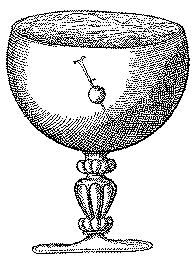Handout #16: Robert Norman's Discovery (1581) – Magnetic Dip
Robert Norman was a compass maker in London. In those days, this is how you made a compass. You produced a flat steel needle, then found the place in the middle where it balanced, and made an indentation, so that the needle could be placed on top of a pivot at that point.
Then you rubbed the steel needle against a lodestone to magnetize it. But a strange thing was noted: when the needle was placed again on its pivot, it no longer balanced. The north-pointing end seemed heavier, and the compass builder had to snip off a bit from that end, to balance it again.
One day Robert Norman spoiled a needle by snipping off too much, and decided to investigate. He balanced a needle on a horizontal axis lined up in the east west direction, and after balancing it carefully, magnetized it. The needle could still point north-south, but now it also had the freedom to point at any angle to the horizontal. Suspended that way, it did not stay horizontal, but tilted its northward-seeking end at a steep angle downwards. This showed that the magnetic force pulling it northward was not horizontal, but slanted downward, into the solid Earth.
 The picture here, from Gilbert's book, shows a magnetized needle held by a small ball of cork or wax. The buoyancy of the ball is enough to keep the needle from sinking, but not enough to make it rise to the top, and instead it hovers between sinking and floating (very hard to actually achieve!). If it is balanced before being magnetized so that the ball is exactly in its middle, after being magnetized its northward-pointing end slants down at the dip angle. If one carefully remagnetizes it in the opposite direction, without moving the ball, its other end should point northwards and downwards.
The picture here, from Gilbert's book, shows a magnetized needle held by a small ball of cork or wax. The buoyancy of the ball is enough to keep the needle from sinking, but not enough to make it rise to the top, and instead it hovers between sinking and floating (very hard to actually achieve!). If it is balanced before being magnetized so that the ball is exactly in its middle, after being magnetized its northward-pointing end slants down at the dip angle. If one carefully remagnetizes it in the opposite direction, without moving the ball, its other end should point northwards and downwards.
This pivoted needle with a scale measuring the dip angle, is nowadays known as a "dip needle"), and here is its picture published in 1600 in William Gilbert's book. Such needles were in fact used for many years, and in 1831, when a British expedition located the north magnetic pole in Northern Canada, they confirmed its location by using such a needle, which pointed straight down.
 Home
Home